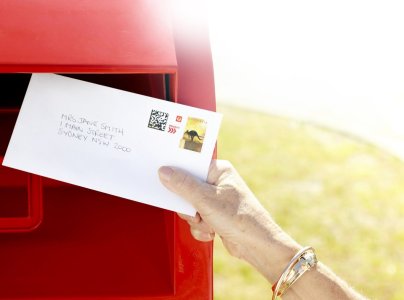Postage price peak: Australia Post's stamp prices soar as letter volumes plummet!
- Replies 18
In an era where digital communication reigns supreme, the humble postage stamp has been holding on, a reminder of a slower, more tactile world of communication.
However, for Australians who still enjoy or rely on sending physical letters, the cost of maintaining this tradition is about to rise significantly.
The Australian Competition and Consumer Commission (ACCC) has recently given the green light for a substantial increase in the price of postage stamps, a decision that reflects the changing landscape of communication and the financial realities of Australia Post's operations.
Starting April 3, the price of an ordinary small letter stamp will jump by a hefty 25 per cent, from $1.20 to $1.50.
This marks a significant shift in the cost of sending a standard letter, and it's not just the small letters that will feel the impact.
The cost of sending ordinary large letters weighing less than 125g will rise from $2.40 to $3.00, while those between 125 and 250g will now set you back $4.50, up from the previous $3.60.

Thankfully, there's a silver lining for concession card holders, who will see their stamp prices frozen at 60 cents.
Additionally, the cost of sending Christmas cards will remain at a modest 65 cents, allowing for the continuation of festive traditions without additional financial burden.
The ACCC's approval of the price hike comes after a months-long consultation process, which began when Australia Post proposed the change in August 2023.
‘We acknowledge the concerns raised in our consultation processes about the impact of the price increase on consumers and businesses, especially in light of cost-of-living pressures,’ ACCC Commissioner Anna Brakey stated.
Australia Post welcomed the decision, stating that the $1.50 increase in price would result in an extra $4.50 per year for the average household.
‘Australian households only receive two letters on average each week, and letter volumes are expected to halve in the next five years,’ Australia Post said.
‘Charities will continue to be able to access our heavily discounted Charity Mail service, while business and government customers, who send more than 95 per cent of all mail in Australia, can access a broad range of discounted services.’
In the recently released Australia Post results, the service announced a half-year profit of $33.6 million, marking an increase from the $10 million recorded during the same period in 2022.
This surge in profit was fueled by a surge in parcel deliveries, which reached nearly 100 million during the summer season.
However, the service's letter business continued to suffer losses, with a reported deficit of $182 million, attributed to a 12 per cent decline in letter volumes over the same period.
Without a previous 10-cent increase in stamp prices implemented in January 2023, the division would have experienced a further $90 million decline in revenue.
 How do you feel about the stamp price increase? Will it affect how often you send letters? Do you have any tips for others on how to manage these rising costs?
How do you feel about the stamp price increase? Will it affect how often you send letters? Do you have any tips for others on how to manage these rising costs?
Share your thoughts and experiences in the comments below.
However, for Australians who still enjoy or rely on sending physical letters, the cost of maintaining this tradition is about to rise significantly.
The Australian Competition and Consumer Commission (ACCC) has recently given the green light for a substantial increase in the price of postage stamps, a decision that reflects the changing landscape of communication and the financial realities of Australia Post's operations.
Starting April 3, the price of an ordinary small letter stamp will jump by a hefty 25 per cent, from $1.20 to $1.50.
This marks a significant shift in the cost of sending a standard letter, and it's not just the small letters that will feel the impact.
The cost of sending ordinary large letters weighing less than 125g will rise from $2.40 to $3.00, while those between 125 and 250g will now set you back $4.50, up from the previous $3.60.

The ACCC has approved Australia Post to increase stamp prices starting April 3. Credits: Australia Post
Thankfully, there's a silver lining for concession card holders, who will see their stamp prices frozen at 60 cents.
Additionally, the cost of sending Christmas cards will remain at a modest 65 cents, allowing for the continuation of festive traditions without additional financial burden.
The ACCC's approval of the price hike comes after a months-long consultation process, which began when Australia Post proposed the change in August 2023.
‘We acknowledge the concerns raised in our consultation processes about the impact of the price increase on consumers and businesses, especially in light of cost-of-living pressures,’ ACCC Commissioner Anna Brakey stated.
Australia Post welcomed the decision, stating that the $1.50 increase in price would result in an extra $4.50 per year for the average household.
‘Australian households only receive two letters on average each week, and letter volumes are expected to halve in the next five years,’ Australia Post said.
‘Charities will continue to be able to access our heavily discounted Charity Mail service, while business and government customers, who send more than 95 per cent of all mail in Australia, can access a broad range of discounted services.’
In the recently released Australia Post results, the service announced a half-year profit of $33.6 million, marking an increase from the $10 million recorded during the same period in 2022.
This surge in profit was fueled by a surge in parcel deliveries, which reached nearly 100 million during the summer season.
However, the service's letter business continued to suffer losses, with a reported deficit of $182 million, attributed to a 12 per cent decline in letter volumes over the same period.
Without a previous 10-cent increase in stamp prices implemented in January 2023, the division would have experienced a further $90 million decline in revenue.
Key Takeaways
- Australia Post has been approved by the Australian Competition and Consumer Commission to increase stamp prices by up to 25 per cent from April 3.
- The price of an ordinary small letter stamp will rise from $1.20 to $1.50, while other postal charges for larger letters will also increase.
- Concession card holders will not experience a price hike, with their costs remaining at 60c, and the price of sending Christmas cards will stay at 65c.
- The increase in stamp prices came amid a significant decline in letter volumes, with the ACCC acknowledging the potential impact on consumers and businesses, but recognising the financial challenges faced by Australia Post.
Share your thoughts and experiences in the comments below.







